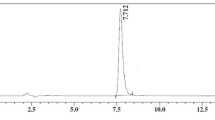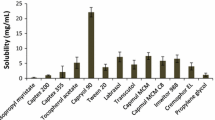Abstract
This research aims to investigate the influence of alkyl polyglucoside (APG) as a co-surfactant in nanoemulsion formulation containing ibuprofen, as a model drug, which intended to be used for topical application. Phase behavior of oil/surfactant/water system containing ibuprofen with different surfactants Cremophor EL(CrEL)/APG ratios (9:1, 8:2, and 6:4) was investigated. The results showed the system with CrEL: APG ratio 9:1 gives the largest isotropic region. When compared to the nanoemulsion formulation with and without APG, it showed that the system with APG exhibited higher emulsifying ability than CrEL surfactant alone which due to the APG co-surfactant could decrease the water affinity and increase the oil affinity of the systems. Several formulations with different surfactant-to-oil (S:O) ratios (1:9 and 9:1) were prepared. The result showed that the formulation containing the S:O ratio of 9:1 exhibited smaller and monodisperse particle sizes than the formulation containing the S:O ratio of 1:9 and it was selected for the preparation of nanoemulsion formulations. The particle size ranged between 20 and 200 nm and a polydispersity index less than 0.25 was obtained. Cytotoxicity results showed that no cytotoxicity effect (IC50 > 500 μg/mL) against 3T3 cell lines for both formulations (with and without APG) with reduced drug release when APG-corporate in nanoemulsion formulation. This shows that APG could be used as alternative stabilizing agent and the formulated nanoemulsion system could be used as a new topical drug carrier system for pharmaceutical applications.







Similar content being viewed by others
References
Pantelic I (2014) Alkyl Polyglucosides: From natural-origin surfactants to prospective delivery systems. Woodhead. ISBN 9781908818775
Hato M (2001) Synthetic glycolipid/water systems. Curr Opin Colloid Interface Sci 6:268–276. https://doi.org/10.1016/S1359-0294(01)00096-6
Jurado E, Bravo V, Vicaria JM, Fernandez-Arteaga A, Garcia-Lopez AI (2008) Triolein solubilization using highly biodegradable non-ionic surfactants. Colloids Surf A 326:162–168. https://doi.org/10.1016/j.colsurfa.2008.05.024
Sazalee SA, Ahmad N, Hashim R (2017) Investigation of self-assembly properties and the effect of tween series co-surfactants on the stability of nonionic branched-chain glycolipid hexosomes. Colloids Surf A 529:210–221. https://doi.org/10.1016/j.colsurfa.2017.05.085
Keck CM, Kovačević A, Müller RH, Savić S, Vuleta G, Milić J (2014) Formulation of solid lipid nanoparticles (SLN): The value of different alkyl polyglucoside surfactants. Int J Pharm 474(1–2):33–41. https://doi.org/10.1016/j.ijpharm.2014.08.008
Fukuda K, Olsson U, Ueno M (2001) Microemulsion formed by alkyl polyglucoside and an alkyl glycerol ether with weakly charged films. Colloids Surf B 20:129–135. https://doi.org/10.1016/S0927-7765(00)00183-1
Ahmad N, Ramsch R, Esquena J, Solans C, Tajuddin HA, Hashim R (2012) Physicochemical characterization of natural-like branched-chain glycosides toward formation of hexosomes and vesicles. Langmuir 28:2395–2403. https://doi.org/10.1021/la203736b
Han Z, Yang X, Liu Y, Wang J, Gao Y (2015) Physicochemical properties and phase behavior of didecyldimethylammonium chloride/alkyl polyglycoside surfactant mixtures. J Surfactants Deterg 18:641–649. https://doi.org/10.1007/s11743-015-1679-5
Lim CJ, Basri M, Omar D, Rahman MA, Salleh AB, Rahman A (2012) Phase behaviour of nonionic surfactants in new palm oil esters-based emulsion for glyphosate isopropylamine formulation. Asian J Chem 24:4601–4605 ISSN 0970–7077. https://www.asianjournalofchemistry.co.in/User/SearchArticle.aspx?Volume=24&Issue=10&Article=&Criteria=
Bhagat BV, Rachh PR (2020) Lipid based non-aqueous nano emulsions: a review. Res J Pharm Tech 13(8):4009–4014. https://doi.org/10.5958/0974-360X.2020.00709.X
Pavoni L, Perinelli DR, Bonacucina G, Cespi M, Palmieri GF (2020) An overview of micro-and nanoemulsions as vehicles for essential oils: formulation, preparation and stability. Nanomaterials 10(1):135. https://doi.org/10.3390/nano10010135
McClements DJ (2012) Nanoemulsions versus microemulsions: terminology, differences, and similarities. Soft Matter 8:1719–1729. https://doi.org/10.1039/C2SM06903B
Tadros T, Izquierdo P, Esquena J, Solans C (2004) Formation and stability of nano-emulsions. Adv Colloid Interface Sci 108:303–318. https://doi.org/10.1016/j.cis.2003.10.023
Solans C, Izquierdo P, Nolla J, Azemar N, Garcia-Celma MJ (2005) Nano-emulsions. Curr Opin Colloid. Interface Sci 10:102–110. https://doi.org/10.1016/j.cocis.2005.06.004
Wooster TJ, Labbett D, Sanguansri P, Andrews H (2016) Impact of microemulsion inspired approaches on the formation and destabilisation mechanisms of triglyceride nanoemulsions. Soft Matter 12:1425–1435. https://doi.org/10.1039/C5SM02303C
Mason TG, Wilking JN, Meleson K, Chang CB, Graves SM (2006). Nanoemulsions: formation, structure, and physical properties. J Phys.: Condens Matter, 18(41):R635. https://doi.org/10.1088/0953-8984/18/41/R01
Salim N, Ahmad N, Musa SH, Hashim R, Tadros TF, Basri M (2016) Nanoemulsion as a topical delivery system of antipsoriatic drugs. RSC Adv 6:6234–6250. https://doi.org/10.1039/C5RA14946K
Tasić-Kostov M, Reichl S, Lukić M, Jaksić I, Savić S (2011) Two alkyl polyglucoside natural surfactants varying in chain length in stabilization of lactobionic acid containing emulsions: physicochemical characterization and in vitro irritation potential assessment. RSC Adv 88:256–264. ISSN 0035–6808
Manoukian MAC, Migdal CW, Tembhekar AR, Harris JA, DeMesa C (2017) Topical administration of ibuprofen for injured athletes: considerations, formulations, and comparison to oral delivery. Sports Med Open 3:1–9. https://doi.org/10.1186/s40798-017-0103-2
Ahmad N, Ramsch R, Llinàs M, Solans C, Hashim R, Tajuddin HA (2014) Influence of nonionic branched-chain alkyl glycosides on a model nano-emulsion for drug delivery systems. Colloids Surf B 115:267–274. https://doi.org/10.1016/j.colsurfb.2013.12.013
Pajić NB, Ilić T, Nikolić I, Dobričić V, Pantelić I, Savić SD (2019) Alkyl polyglucoside-based adapalene-loaded microemulsions for targeted dermal delivery: structure, stability and comparative biopharmaceutical characterization with a conventional dosage form. J Drug Delivery Sci Technol 54:101245. https://doi.org/10.1016/j.jddst.2019.101245
Ilic D, Cvetkovic M, Tasic-Kostov M (2021) Emulsions with alkyl polyglucosides as carriers for off-label topical spironolactone–safety and stability evaluation. Pharm Dev Technol 1–25. https://doi.org/10.1080/10837450.2021.1874011
Sadurní N, Solans C, Azemar N, García-Celma MJ (2005) Studies on the formation of O/W nano-emulsions, by low-energy emulsification methods, suitable for pharmaceutical applications. Eur J Pharm Sci 26:438–445. https://doi.org/10.1016/j.ejps.2005.08.001
Hasan HM, Leanpolchareanchai J, Jintapattanakit A (2015) Preparation of virgin coconut oil nanoemulsions by phase inversion temperature method. Advanced Materials Research 1060:99–102. https://doi.org/10.4028/www.scientific.net/AMR.1060.99
Salim N, García-Celma MJ, Escribano E, Nolla J, Llinàs M, Basri M, Solans C, Esquena J, Tadros TF (2018) Formation of nanoemulsion containing ibuprofen by PIC method for topical delivery. Mater Today: Proc 5:S172–S179. https://doi.org/10.1016/j.matpr.2018.08.062
Djekic L, Primorac M, Filipic S, Agbaba D (2012) Investigation of surfactant/cosurfactant synergism impact on ibuprofen solubilization capacity and drug release characteristics of nonionic microemulsions. Int J Pharma 433(1–2):25–33. https://doi.org/10.1016/j.ijpharm.2012.04.070
Djekic L, Primorac M, Jockovic J (2011) Phase behaviour, microstructure and ibuprofen solubilization capacity of pseudo-ternary nonionic microemulsions. J Mol Liq 160:81–87. https://doi.org/10.1016/j.molliq.2011.02.010
Hadzir NM, Basri M, Rahman MBA, Salleh AB, Rahman RNZRA, Basri H (2013) Phase behaviour and formation of fatty acid esters nanoemulsions containing piroxicam. AAPS PharmSciTech 14:456–463. https://doi.org/10.1208/s12249-013-9929-1
Azhar SNAS, Ashari SE, Salim N (2018) Development of a kojic monooleate-enriched oil-in-water nanoemulsion as a potential carrier for hyperpigmentation treatment. Int J Nanomed 13:6465. https://doi.org/10.2147/IJN.S171532
Clément P, Laugel C, Marty JP (2000) Influence of three synthetic membranes on the release of caffeine from concentrated W/O emulsions. J Controlled Release 66:243–254. https://doi.org/10.1016/S0168-3659(99)00276-X
Mosca M, Cuomo F, Lopez F, Ceglie A (2013) Role of emulsifier layer, antioxidants and radical initiators in the oxidation of olive oil-in-water emulsions. Food Res Int 50:377–383. https://doi.org/10.1016/j.foodres.2012.10.046
Jiang LC, Basri M, Omar D, Rahman MBA, Salleh AB, Rahman RNZRA (2011) Self-assembly behaviour of alkylpolyglucosides (APG) in mixed surfactant-stabilized emulsions system. J Mol Liq 158:175–181. https://doi.org/10.1016/j.molliq.2010.11.015
Salim N, Basri M, Rahman MB, Abdullah DK, Basri H (2012) Modification of palm kernel oil esters nanoemulsions with hydrocolloid gum for enhanced topical delivery of ibuprofen. Int J Nanomed 7:4739–4747. https://doi.org/10.2147/IJN.S34700
Fanun M (Ed) (2008) Microemulsions: properties and applications. ISBN 9781420089592
Dammak I, Sobral PJDA, Aquino A, Neves MAD, Conte-Junior CA (2020) Nanoemulsions: Using emulsifiers from natural sources replacing synthetic ones—a review. Compr Rev Food Sci Food Saf 19:2721–2746. https://doi.org/10.1111/1541-4337.12606
Danaei M, Dehghankhold M, Ataei S, Hasanzadeh Davarani F, Javanmard R, Dokhani A, Khorasani S, Mozafari MR (2018) Impact of particle size and polydispersity index on the clinical applications of lipidic nanocarrier systems. Pharmaceutics 10:57. https://doi.org/10.3390/pharmaceutics10020057
Matsaridou I, Barmpalexis P, Salis A, Nikolakakis I (2012) The influence of surfactant HLB and oil/surfactant ratio on the formation and properties of self-emulsifying pellets and microemulsion reconstitution. AAPS PharmSciTech 13:1319–1330. https://doi.org/10.1208/s12249-012-9855-7
Zhang Z, Li K, Tian R, Lu C (2019) Substrate-assisted visualization of surfactant micelles via transmission electron microscopy. Front Chem 7:242. https://doi.org/10.3389/fchem.2019.00242
Bajaj S, Singla D, Sakhuja N (2012) Stability testing of pharmaceutical products. J App Pharm Sci 2:129–138. https://doi.org/10.7324/JAPS.2012.2322
Pongsawatmanit R, Srijunthongsiri S (2008) Influence of xanthan gum on rheological properties and freeze–thaw stability of tapioca starch. J Food Eng 88:137–214. https://doi.org/10.1016/j.jfoodeng.2008.02.009
Wang K, Li G, Zhang B (2018) Opposite results of emulsion stability evaluated by the TSI and the phase separation proportion. Colloids Surf A 558:402–409. https://doi.org/10.1016/j.colsurfa.2018.08.084
Sheth T, Seshadri S, Prileszky T, Helgeson ME (2020) Multiple nanoemulsions Nat Rev Mater 5:214–228. https://doi.org/10.1038/s41578-019-0161-9
Santos J, Calero N, Trujillo-Cayado LA, Garcia MC, Muñoz J (2017) Assessing differences between Ostwald ripening and coalescence by rheology, laser diffraction and multiple light scattering. Colloids Surf B 159:405–411. https://doi.org/10.1016/j.colsurfb.2017.08.015
Chantaburanan T, Teeranachaideekul V, Chantasart D, Jintapattanakit A, Junyaprasert VB (2017) Effect of binary solid lipid matrix of wax and triglyceride on lipid crystallinity, drug-lipid interaction and drug release of ibuprofen-loaded solid lipid nanoparticles (SLN) for dermal delivery. J Colloid Interface Sci 504:247–256. https://doi.org/10.1016/j.jcis.2017.05.038
ElMeshad AN, Tadros MI (2011) Transdermal delivery of an anti-cancer drug via w/o emulsions based on alkyl polyglycosides and lecithin: design, characterization, and in vivo evaluation of the possible irritation potential in rats. AAPS PharmSciTech 12(1):1–9. https://doi.org/10.1208/s12249-010-9557-y
Arbain NH, Salim N, Masoumi HRF, Wong TW, Basri M, Rahman MBA (2019) In vitro evaluation of the inhalable quercetin loaded nanoemulsion for pulmonary delivery. Drug Delivery Transl Res 9:497–507. https://doi.org/10.1007/s13346-018-0509-5
Li ZH, Cai M, Yang K, Sun PL (2019) Kinetic study of d-limonene release from finger citron essential oil loaded nanoemulsions during simulated digestion in vitro. J Funct Foods 58:67–73. https://doi.org/10.1016/j.jff.2019.04.056
Funding
This study is funded by the research project from the Ministry of Higher Education Malaysia through the FRGS (FP046-2014A) and the University of Malaya through the UMRG (RG-345-17AFR).
Author information
Authors and Affiliations
Contributions
All authors contributed to the study conception and design. Material preparation and data collection were performed by Nurul Shahidah Mohamad Shahripoddin. Data analysis and discussion were performed by Nurul Shahidah Mohamad Shahripoddin, Norazlinaliza Salim, and Noraini Ahmad. The first draft of the manuscript was written by Nurul Shahidah Mohamad Shahripoddin and all authors commented on previous versions of the manuscript. All authors read and approved the final manuscript.
Corresponding authors
Ethics declarations
Competing interests
The authors declare no competing interests.
Additional information
Publisher's Note
Springer Nature remains neutral with regard to jurisdictional claims in published maps and institutional affiliations.
Rights and permissions
About this article
Cite this article
Mohamad Shahripoddin, N.S., Salim, N. & Ahmad, N. Influence of alkyl polyglucoside on physicochemical characteristics and in vitro studies of ibuprofen-loaded nanoemulsion formulations. Colloid Polym Sci 299, 1631–1642 (2021). https://doi.org/10.1007/s00396-021-04889-4
Received:
Revised:
Accepted:
Published:
Issue Date:
DOI: https://doi.org/10.1007/s00396-021-04889-4




